Exploring the ins and outs of the rental market – John McGrath
This month’s quarterly Rental Review from Cotality revealed national vacancy rates and rental listings have reached new record lows. The report showed the number of national rental listings is now 25% below the five-year average for this time of year. The national vacancy rate has also dropped to 1.47% - or less than half the pre-COVID decade average of 3.3%, according to Cotality economist Kaytlin Ezzy.
Unsurprisingly, these new drops have resulted in another uplift in rents, particularly in Brisbane and Sydney. The median weekly rent for Brisbane dwellings is now $696, following a 5.6% annual lift. In Sydney, median weekly rents have risen 5.6% across the year to reach $807.
But there is more to our rental market than first meets the eye.
Extra investors but struggles continue
The Rental Review revealed that the extra investors who’ve recently joined the market have had minimal impact on either vacancy rates or rents. “While investors have comprised an elevated portion of home lending over the past two years, this hasn’t translated into additional available rental stock,” the report stated.
Certainly, new investor home loans outweigh owner-occupier ones. A PropTrack study showed that in the 18 months to June 2025, the number of new investor loans was almost as high as those of early 2022, when they reached their peak point for the decade. PropTrack believes this is mainly due to national cash rates undergoing a sustained setting of just 0.1% at this time.
The Reserve Bank of Australia’s latest Financial Stability Review agreed.
“Historically, investor activity in the Australian housing market has tended to pick up in response to lower interest rates. Growth in investor housing lending has increased further over the past year and is above its post-Global Financial Crisis (GFC) average,” the report stated.
So, with all this in mind, why the continuing rental lifts and vacancy rate drops?
According to the Annual Property Investor Sentiment Survey released last month, investors are also leaving the market at record rates. The Property Investment Professionals of Australia report revealed that 16.7% of investors sold at least one property in the past year – up from 14.1% in 2024 and 12.1% in 2023. And only 42% of these sold properties were purchased by other investors, rather than owner-occupiers; or in other words, still remain in the rental pool.
The report showed a growing number of investors are also uneasy about the market, partly because of proposed federal reforms including negative gearing policies. And contrary to what many tenants may believe, rental increases aren’t helping most investors either – and remember, 72% of Aussie investors are small-timers, owning just one rental property, according to FY2023 Australian Tax Office figures released in August.
The PIPA survey shows that similar to last year, 65% of investors have only passed on 10% or less of their increased costs through rent hikes. Yet 39% of investors reported operational lifts of 11% to 20%, up 34% on year.
Limited supply the real problem
The Rental Review from Cotality noted that property supply is a major factor driving the re-acceleration in rental growth, and I agree.
Cotality added that supply is particularly tight in the unit sector and even more so in Sydney. In September, this city recorded a new record low vacancy rate across both its unit sector and its broader dwelling rental market, with rates of 1.35% and 1.64% respectively.
What next?
It’s a tough market for both investors and tenants at the moment. But if you know anything about real estate, you’ll know that it experiences cyclical downswings and upswings, with market conditions often changing.
It’s true that we’re currently experiencing a seller’s market but as I tell every buyer and seller out there – and this includes investors too – don’t give up. There’s no 100% perfect time to invest in property. But do your due diligence and your investment can be a highly worthwhile asset for many years to come.

By
John McGrath
October 19, 2025
3 min read
Share this Article


.jpeg)

